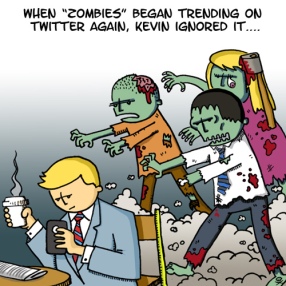In a new post series, First Steps Into Social will focus on specific industries and seek to provide some starting points for those new to (and perhaps overwhelmed by) the world of social media.
Last week we looked at some steps a veterinarian can take into social. This week our stomachs lead us and we can’t resist serving up some advice for restaurant owners everywhere.
For those involved in food service, why not look at these first steps into social media:
- Work up the appetites of your audience by posting mouth-watering descriptions of your daily specials. Whole Foods Market do this regularly on Twitter for their cafe/buffet options.
- Create a blog with varied content about both your own restaurant and others in your community. Write about your own dishes, their history, look into the origins of the type of food you serve. Write about the neighborhood or town in which you operate, how it defines your restaurant and the type of clientele you serve. Build a picture in the reader’s mind of who you are, the type of dining experience you’ll give them, and background as to where it came from.
- Ask your clients to tell you about their favorite experience at your restaurant, what they ate, drank, and how the atmosphere added to their meal. Then, with their permission, write a blog post about it with pictures of the dishes and area in which they sat. Better yet, encourage them to share the experience on Facebook or as a Google or restaurant site review. Take a look at the number of the Lombardi’s Pizza 4 and 5 star reviews on Google alone and decide how you can get people buzzing about your delicious menu.
- Set up listening stations to monitor discussion of both your business and other dining experiences in your town/region. Respond to comments, good or bad, about your restaurant via the same media used to express them, thanking any praise and engaging any criticism to turn the situation around. Search more generally a couple of hours before the main meals you serve to find prospective customers looking to eat in your area. If you engage them and alert to your delicious menu, they may well feel special enough to come in and give you a try.
- Extend the in-house comment/suggestions cards to ask for customer reviews on their favorite restaurant or business listing sites. Offer a return incentive of a discount or free item for those who can point to a review. Do the same for customers who share their experience on Facebook and return with friends.
- Register on Foursquare and other location-based social networks such as Gowalla and Loopt. Participate in the game format of sites that use it by advertising specials or privileges for the top user, as Milwaukee’s AJ Bombers do for their ‘Foursquare Mayor‘. Use the sites yourself wherever possible to understand the nuances of each and how best to encourage user discussion of your restaurant.
- Look into offering a group buying coupon through a site such as Living Social or Groupon, if they operate in your area. Such services usually offer $xx dollars worth of food/drink for a reduced rate, often as much as 50 or 60%, encouraging initial buyers to share with their friends for a night out. They also receive the offer free if enough of those they share with purchase too, giving an added incentive. Even for those that don’t buy, the e-mail and shared advertising raises awareness of your business to those in your area.
.
Food and drink have a special place in the hearts of social media users, as the platforms are more more frequently used to share insights on delicious treats or less palatable experiences. This offers the restauranteur – and indeed most food service providers – a fantastic opportunity to whet the appetites of existing customers and seek out the hungry and thirsty individuals that are just waiting to visit your establishment.
Bon appetit!
.
As a hungry social media user, what lures you into new places to eat and/or drink? What turns you off?
As the proprietor or employee of a restaurant/food service provider, what experiences have you had in using social media to increase your custom?
.
Photo credit: Devlyn




 Posted by Steve Birkett
Posted by Steve Birkett 
 We love the work of
We love the work of 








